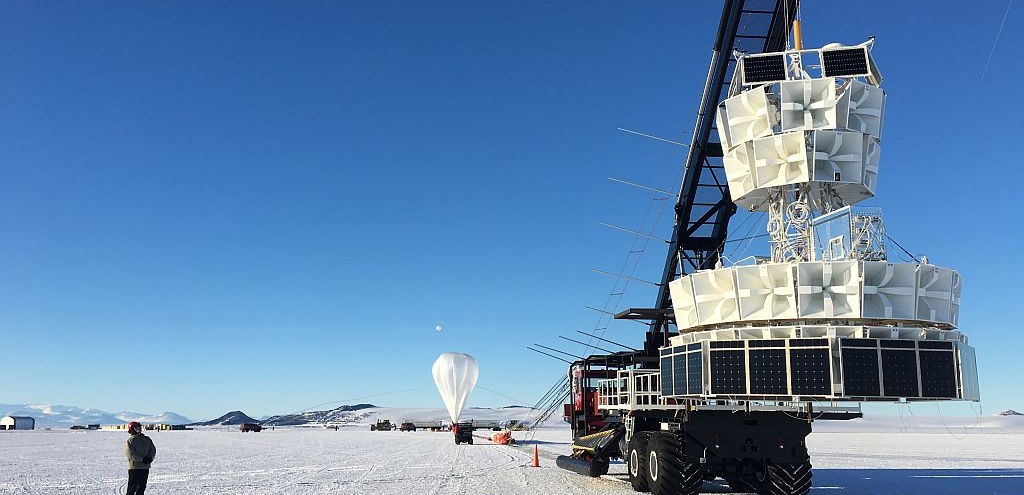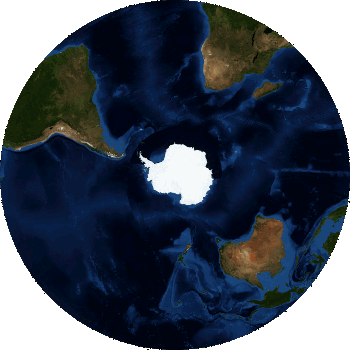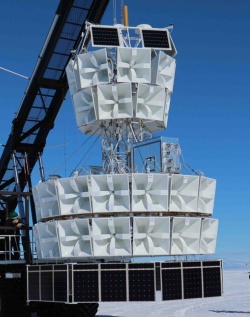News Archive
-
December, 6 2016
ANITA IV mission launched from McMurdo
McMurdo Station, Antarctica.- The second mission of the 2016/2017 NASA balloon launch campaign in the white continent, started a few days ago, with the launch of a stratospheric balloon measuring 39.000.000 cubic feet of volume, from the Williams Field airport near McMurdo station. Unlike last year's, the weather seems to be more cooperative and allowed to have in the air two of three payloads in such an early stage of the summer launch window.
The balloon was launched by personnel from NASA's Columbia Scientific Balloon Facility (CSBF) with support of the National Science Foundation (NSF) at 13:10 utc on December 2, 2016 being nomenclated as mission 675N. After a nominal ascent of near four hours, it reached float altitude of 130.000 ft starting as usual an anticyclonic path around the pole.
Onboard was one of the most strange-looking instruments ever flown in a balloon. Called ANITA -acronym for Antarctic Impulsive Transient Antenna- the instrument's goal is to study from the stratosphere ultra-high-energy (UHE) cosmic neutrinos by detecting the radio pulses emitted by their interactions with the Antarctic ice sheet below. The instrument is the fruit of a collaboration between the University of Hawaii at Manoa, the University of California (LA), the Ohio State University, the University of Delaware, the University of Kansas, Washington University, the NASA Jet Propulsion Laboratory, University College London, University of Chicago and National Taiwan University.
Last year, when NASA asked for help to recover that same experiment launched from McMurdo in December 2014, after landing near the Davis Station, they reported to their colleagues of the Australian Antarctic Program that the apparatus resembled "the torch for a cubist statue of liberty, a high-concept chandelier and a monster sound system". A description not so far from reality if we see the picture above (click to enlarge). The image was took by @LindaCremonesi during a hang test performed a day before the launch.
The working principle behind the "splendidly improbable beast" as another scientist described ANITA is the Askaryan Effect, discovered in 1962 by the Soviet-Armenian physicist Gurgen Askaryan. He postulated that a particle traveling faster than the phase velocity of light in a dense dielectric (such as salt, ice or the lunar regolith) produces a shower of secondary charged particles and thus emits a cone of coherent radiation in the radio or microwave part of the electromagnetic spectrum.

For the purpose of detecting these signals, ANITA's structure is composed of an array of dual-polarization, broadband antenna clusters with overlapping fields-of-view, combined with a trigger system inherited from other radio frequency impulse detection instruments, both space and ground based. To fully retain sensitivity to most of the potential ice volume available for neutrino event production, the array of antennas should view most of the entire Antarctic ice sheet beneath the balloon and out to the horizon in all directions, hence the particular design adopted.
ANITA is a "veteran" from NASA balloon campaigns in Antarctica. On this season the experiment is performing it's fourth scientific tour on the ice after three previous missions: ANITA I in 2006, followed by ANITA II in 2008 and more recently in 2014 by ANITA III. The main features of this fourth incarnation of the instrument includes a lighter overall build in the structure, the inclusion of tunable notch filters and a much more improved trigger system.
High altitude calibration
Another project led by a team of the University of Kansas and denominated Hi-Cal is taking part of the launch campaign. This small payload, which will be flown in small hand-launched polyethilene balloon a few days after ANITA is aimed to serve as a sort of "calibration" for it. Moving hundred of miles behind the ANITA balloon but following more or less the same route, it will transmit pulses at a predetermined rate emulating the radio signals produced by ultra-high energy cosmic rays. These pulses will be received by ANITA both directly and as signals reflected from the ice surface. Then the ratio of the amplitudes of reflected to direct signals would provide a direct measurement of any decoherence effects caused by surface roughness.
Before "Hi-Cal" the calibration transmitters were located on the ground. As an example, for ANITA II flight in 2008, two of these devices were active one in a 90 meter deep hole drilled in the ice at Taylor Dome -a field camp location approximately 200 km west of McMurdo station- and in a 25 meters deep borehole at Williams Field, the balloon launch location. They transmitted at predetermined intervals during the entire flight of the instrument.

Starting with ANITA III in 2014, the new balloon-based aproach was used. On that campaign two "Hi-Cal" balloons were launched, one in December 2014 which failed and another in January 2015, which was sent aloft after ANITA passed close to McMurdo in it's second tour around the continent.
Initial plans were to launch the calibration payload 24/48 hours after ANITA IV, but at the moment of writing this, the main balloon is located far from McMurdo (see map at right) and "Hi-Cal" was not launched yet.
Let's see what happens when the balloon returns to McMurdo in the next few days.
-
Share this on social media



